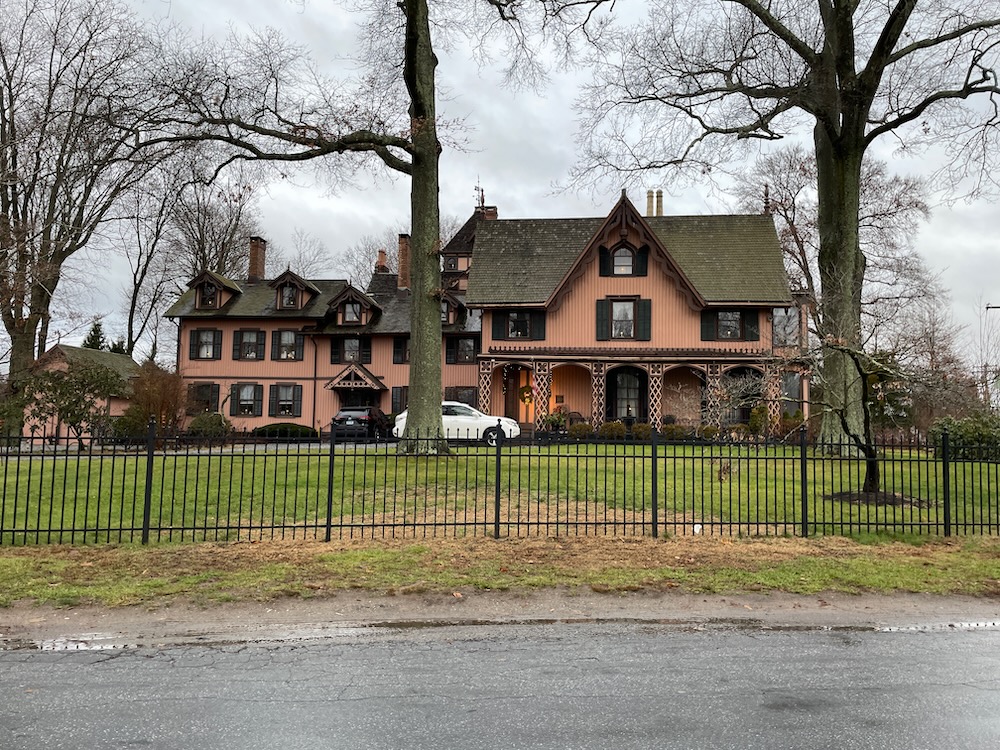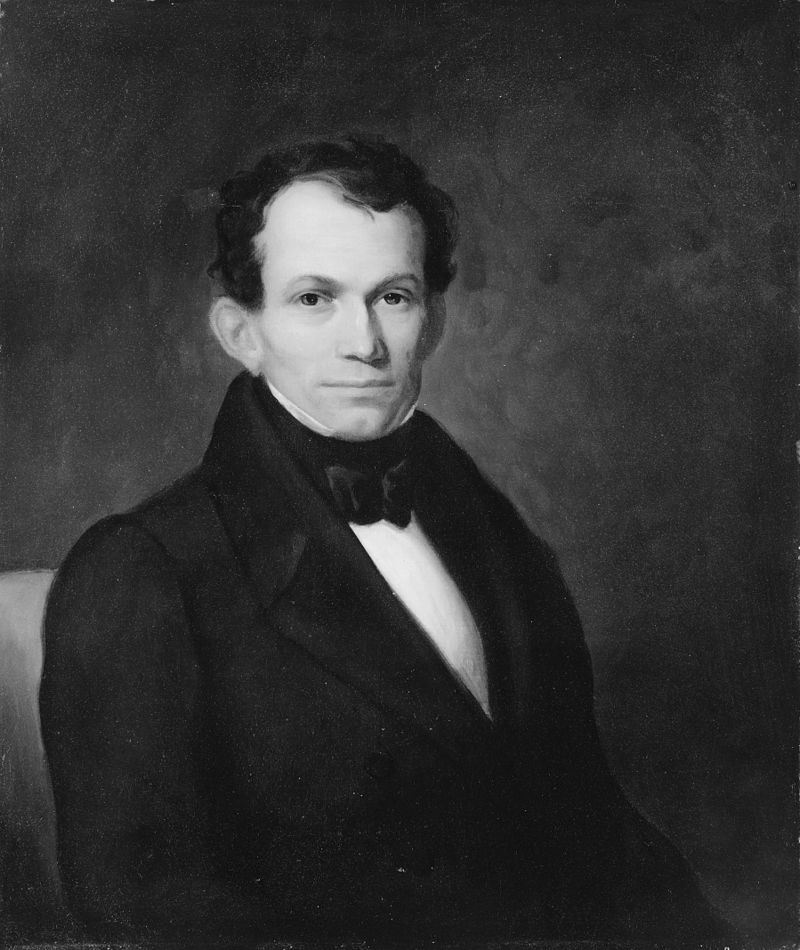CT National Historic Landmark
Jonathan Sturges House
Fairfield
Back in the early days of CTMQ… back when this whole monster was a different website entirely… I had a page about the Jonathan Sturges House. I had driven by (just as I’ve done more recently in 2022), taken a bad picture from the car (just as I’ve done in 2022), and proceeded to write about the wrong Jonathan Sturges. Several paragraphs’ worth.
I published it and went about my merry way. Then a kind commenter alerted me to my mistake and I vowed to correct it (by deleting it). Welcome to the story of the correct Jonathan Sturges and his former home on Mill Plain Road in Fairfield!

Built in 1840 to a design by Joseph Collins Wells, it is one of the oldest-known and best-documented examples of architect-designed Gothic Revival architecture! The house was declared a National Historic Landmark in 1994 for its architectural significance! It was designed and built for Sturges, a New York City businessman and patron of the arts. He died in 1874, but the house remains in the same family today. It is known as “The Cottage.”
It is a striking house to say the least; containing more than 30 rooms and 11 staircases. There are 13 fireplaces, four kitchens and six stories, including an ice house below the cellar and a book tower at its pinnacle. The whole thing was built in stages over 55 years, from 1840 to 1895. Well, the architect, also designed Roseland Cottage in Woodstock – also a National Historic Landmark. Oh, and it was one of the first homes to combine the toilet and bath in one private room. Huzzah!

Jonathan Sturges
I believe The Cottage has never left the private ownership of the Sturges family. In 2019, a local reporter named Steven Gaynes was given a tour by two great great granddaughters of Sturges – the current owners. As is the case these days, there’s no point linking it because it’s behind a paywall and the link won’t work in short order, but I’ve copied and pasted most of it below.
It’s worth reading. It could be titled, “Wealthy Fairfield County People Marrying Other Wealthy People”, or… “Wealthy Fairfield County People Who Are So Wealthy They Don’t Care About Millions of Dollars of Fine Original Paintings”, or perhaps we’ll just stick with what it is – a cool look inside this unique National Historic Landmark.
![]()
From the moment I stepped into The Jonathan Sturges “Cottage,” I was swept into a world where Fairfield history and glamor have merged to create a true showplace. The overall transformation of this beautiful mansion was largely orchestrated by co-owner Polly Roessler’s late mother Mary B. Rousseau, who purchased the property from the estate in 1979. According to Polly, “Mary B. Rousseau lived and maintained the “Cottage” for over 40 years. She had a deep love, devotion and unwavering support for her immediate and extended family. She was an accomplished artist, having attended the Arts Students League in New York and specialized in dog portraits.
“Mary graciously entertained, opening up the “Cottage” for all manner of events, family gatherings, charitable organizations, weddings, reunions. Her generosity knew no bounds. She was an active volunteer at Trinity Episcopal Church, the Women’s Exchange in Southport and a member of the CT Trust for Historical Preservation and a former fellow of the Morgan Library.”
Polly’s great grandfather was Henry Cady Sturges, one of Jonathan’s Sturges’ sons, who graduated with a law degree from Columbia University but never practiced. Instead, he became a yachtsman and “country gentleman” who preferred sailing to work. He married 18-year-old Sarah Adams McWhorter when he was 38.
Polly also spoke with warmth and pride about the rest of her family and especially about her great-great grandfather Jonathan Sturges and her great-great grandmother Mary Cady Sturges and about the original home they created on farmland in Fairfield. Among Jonathan’s memorable accomplishments was his founding of the Illinois Central Railroad. Abraham Lincoln was the lawyer for the railroad. Jonathan was also a noted patron of the arts, supporting the Hudson River Painters, and many of those artists’ paintings or copies adorn the walls in the “Cottage.”
We began our tour in the enormous parlor of the “Cottage.” As we entered the parlor, with its parquet floors, I was immediately struck by a copy of a painting on the wall, entitled “Kindred Spirits” which was commissioned by Jonathan Sturges and painted by Asher B. Durand. The painting was of poet William Cullen Bryant and fellow artist Thomas Cole. The original hung for many years in the New York Public Library before being sold to an heir to the Wal-mart family for $35 million. It was later donated to Wal-mart’s Crystal Museum.
A magnificent mirror above the parlor fireplace had Polly chuckling as she told its story. Apparently an art dealer approached her great-great grandmother, Sarah McWhorter Sturges, wife of Henry Cady Sturges, looking for fine art. She suggested looking in the cellar, and he found an old painting of Crawford’s Notch in the White Mountains of New Hampshire by artist Thomas Cole and convinced Mrs. Sturges to sell it for not a lot of money.
Once the money was exchanged, the dealer promptly cut the painting out of its frame and left. Mrs. McWhorter thought it odd that the dealer didn’t want the frame and she used it instead for the beautiful mirror in the parlor. Today, the Crawford’s Notch painting, worth more than a million dollars, hangs in Washington, D.C.’s National Gallery.
As we left the parlor, Polly showed me a gorgeous music box that her grandmother acquired about 1904. Whenever Polly’s mother was ill, Annie Sturgis Bullard brought her the music box.
In the next room, which was a bright, cheery sitting room, Polly pointed out a copy of a second painting – “Rainy Seasons in the Tropics” done by Artist Frederick Church in the 1860s. Henry Sturges obtained it in about 1889 and the heirs sold it to a Connecticut art dealer in the 1960s for a few thousand dollars — after it had fallen off the wall in the library and tore the painting. Today, the painting, worth millions, hangs in San Francisco’s DeYoung Museum.
As we entered a formal dining room and I noticed a beautiful lace veil, Polly explained that it belonged to Jonathan and Mary’s daughter Amelia, who became the bride of financier J.P. Morgan. They were deeply in love. Tragically, Amelia became ill with a cold and eventually tuberculosis and literally had to be carried into the parlor for their wedding ceremony. She died in Nice soon after on their honeymoon.
I was amazed as we walked into the more modern sections of the “Cottage” to learn about the innovations and personal touches from Jonathan and Mary and their various descendants like Polly’s grandmother Annie Sturges Bullard and grandfather, Roger Bullard, a New York architect. For example, the original house includes one of the first bathrooms in Connecticut, built in 1840. The bathroom was installed a year before the first bathroom in the White House. There was also a primitive kind of paging system, an early sewing room, and a charming day nursery.
Polly also pointed out that the original coal-burning furnace is still there, along with the remnants of an ice house under a sub=floor in the cellar. Younger family members would bring back ice from nearby Perry’s Pond and store it in sawdust to use on hot summer days.
In a far end of the newer sections of the house, past the four kitchens, we entered Grandmother Annie Sturges’ Bullard’s sculpting studio, which later became Polly’s mother’s studio for the hundreds of dog portraits she painted, Polly said.
In a writing room on the second floor, Polly shared that her grandmother had been a writer for early editions of Redbook magazine. It was incredible to see that many of the cover headlines looked similar to those in today’s world.
Two other places among the many memorable spots in the “Cottage” really struck me. One was a bride’s bedroom, recently renovated. It contained the gowns, veils and gloves of Sarah Adams McWhorter, Henry Cady Sturges wife; her daughter and Polly’s grandmother, Annie Sturgis Bullard, Polly’s own gown and that of her daughter.
The other room that fascinated me was the Book Tower, added by Polly’s great grandfather Henry in 1883 to accommodate all of the first edition titles he was accumulating. Every window had dark shades to protect the book bindings and one section of windows looked out onto turrets.
While my journey through Sturges history lasted 2 hours, I believe I barely grazed the surface of this special architectural treasure right in the heart of Fairfield.
![]()
CTMQ visits CT’s National Historic Landmarks
CTMQ’s CT National Designations

Leave a Reply